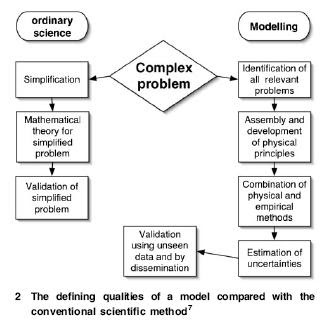
In April, I drew your attention to this No. of Materials Science & Technology (Feb 08 Vol 24 ) in particular to the four Mathematical Modeling papers. While awaiting members feedback, comments etc., I have chosen to summarise my favorite paper in this issue:
Mathematical models in materials science pp. 128-136(9) Author: H.-Bhadeshia, H.K.D.H.
I cannot help admiring Prof.Harry Bhadeshia’s thinking and writing. His review paper
Mathematical models in materials science I feel, is very well balanced indeed. The pros and cons, yes there are cons, are both superb examples in positive critical thinking. The review is timely.
Right from the start his Abstract sets the scene for his review.
He graphically portrays two visions or methods of modelling, the linear whereby the relative length scales are important and an interdisciplinary – disconnected approach
(fig.1. above)
Harry-Bhadeshia draws upon historical developments with salient examples of the undoubted successes and the redoubtable excesses one encounters so often with all new methods and approaches. A sort of "dedicated follower of fashion syndrome which does not I surmise exclude money, always, in fashion-the necessary evil!)Harry stresses the fact that models however useful do not explain Nature and quotes,Nobel Prize Winner 1977, PHILIP W. ANDERSON[Pdf format-LINK] of Bell Labs. & Princeton Univ.
"After all, the perfect
computation simply reproduces Nature, it does not
explain her."
I may add that this message did not go unheeded, both following Nobels P-G. Gennes (1991) & G. Charpak (1992) in France have confirmed their sharing & support, authoring books, of the “Andersonian View” (incidentally the homonym of my original Univ in Glasgow, Strathclyde which started life as the Andersonian Institute arguably a precursor of such approaches.)
Harry-Bhadeshia clearly underlines the differences and complimentary aspects of Modelling vs. the classical scientific method.
How then does this differ from ordinary
science, which also yearns for the mathematical formulation
of Nature? cf Fig2.

Harry-Bhadeshia defines four classes of models:
“Models might be classified as follows:
(i) those which lead to an unexpected outcome that
can be verified
(ii) those which are created or used in hindsight to
explain diverse observations
(iii) existing models which are adapted or grouped
to design materials or processes
(iv) models used to express data, reveal patterns, or
for implementation in control algorithms.
and he notes that "While these categories are not exclusive, they serve to highlight the applications of models, with the emphasis being on quantitative expression, whether that is fuzzy or discrete.”
Excess information and information loss is considered. If ever a theme largely surpasses the relms of Maths Modeling this is one, few in modern economies are spared:
Harry uses a more explicit expression than “Information overflow!” and “pulls our collective ear", sharply, in offering a couple of explainations for our “lack of nerve, concentration, diligence…” as one may expect of good teacher,
Comments, welcome.
Quote:"These examples highlight the fact that researchers often have the capability to collect fine detail but perhaps not the patience or skill to exploit that information fully. Precisely the same issues arise in materials modelling where data can often be generated at resolutions not possible using experiments (for
example, heat and fluid flow during welding). The outputs of such methods are ‘coarse grained’ before publication." (I presume due to the peer refereeing process)
Further criticisms raised are:
“Similarily atomistic calculations require huge computing resources, and yet the answers they produce are quite simple, for example, the cohesive
energy of postulated crystal structures or the elastic moduli.”
“The danger with computationally intensive methods is that the focus shifts on the final outcome rather than on the steps leading to that solution.”
“It is difficult to assess the utility of large quantities of data when scientific expertise tends to be highly specialised.”
Harry suggests that: “good practice would be to make the data freely available so that others can look at the information with a fresh perspective. The World Wide Web makes this (technically) an easy task to implement.”
He supports this approach with reference to creep data made available and exploited.
Fuller details are available in the published review. However more information is available via the University of Cambridge, NPL:
umMaterials Algorithms Project and is an important step in the direction of WWW data handling and exploitation arguably another expression of The Andersonian View: “A place of useful learning”.
The many succsesses obtained by computational thermodynamic approaches are discussed together with their limitations, notably, the phases to be calculated must be known.
Many other topics in both experimental (validation) and mathematical modelling are discussed in clear terms such as:
-Uncertainty; graphical examples types of uncertainty are discussed ,
-Neural Networks are demystified,
-Generic Algorithms are recommended for design problems since they usually begin with a -specification of the required properties. So a model may be used to find the domain of inputs that lead to the desired properties (outputs), often by a trial and error.
-Strong steels whereby mathematical modelling led to the invention of new products, eg. Blastalloy 160, blast resistant steel, designed for fighting ship hulls, has a yield strength of 1110 MPa and a Charpy toughness of roughly 176 J at room temperature.
-Creep resistant steels – a notable failure according to Prof Bhadeshia who with hindsight offers some hints as to why both theory (and practise) had been relative failures vs. the amount of effort invested.
-Expense of modelling- insights from an experienced user.
-Model validation – ditto.
I shall not quote from Harry’s insightful conclusions but leave this to the enlightened reader’s initiative. Indeed a fully worthwhile read. I strongly recommend it for both specialists and general metallurgical and materials science professionals and managers.
JA.






















1 comment:
Following my request to Prof. Harry Bhadeshia for permission and approval of my web-log "Review" his excellant review: Here is his personal reply:
"Thank you James, first for reading the articles so diligently and then going to the trouble of commenting.
Best wishes, Harry"
Post a Comment